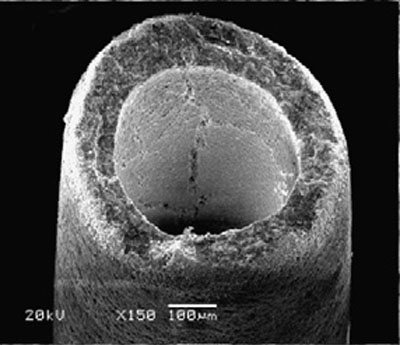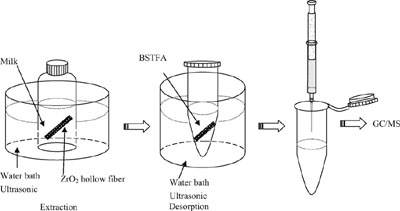|
A novel analytical method based on enrichment and pretreatment of analytes in the milk sample, hollow fiber sorptive extraction and gas chromatography–mass spectrometry for the rapid analysis of melamine in the dairy products was developed by the research group headed by Prof. Shi Yan-ping of the Key Laboratory for Natural Medicine of Gansu Province of the Lanzhou Institute of Chemical Physics, Chinese Academy of Sciences. In the proposed method, melamine in the fresh milk was extracted by zirconia hollow fiber, enriching on zirconia coating of the hollow fiber, and then analyzed by GC–MS. The method validations including linearity, limit of detection, limit of qualification, recoveries at three different concentrations, precision, and repeatability were investigated. It was found that the proposed method provided linear range from 0.001 to 1000 g/mL (r2 = 0.9997), low detection limit of 0.001 g/mL, and preferable recoveries at three different concentrations. The obtained results demonstrated that zirconia hollow fiber combined with GC–MS is a simple, rapid and solvent-free method for the analysis of melamine in the dairy products.
This research has demonstrated that HFSE combined with GC–MS is a sensitive and selective technique for the determination of melamine residues in dairy samples at low g/mL level. It takes a few hours to quantitatively determine the content of melamine residues in the milk. The biggest advantages of the proposed method are: simple and fast collection from milk, extraction and concentration with HFSE, and fast analysis by GC–MS. HFSE combined with GC–MS can significantly reduce solvent consumption and time for purification and pretreatment in the sample preparation. Thus, due to its efficiency and convenience, HFSE combined with GC–MS could become a potential tool for quality control to monitor the amount of melamine residues in the milk products.
The research was published in Journal of Chromatography A and was highly praised by the reviewers of the journal. They said that the research provided an elegant approach for analyzing milk products for melamine residues without typical sample preparation techniques that involve protein precipitation and sample clean-up and the method was fast, accurate, quantitative and timely. And the importance of the development of such a method is obvious given the issues with melamine contamination in milk and the subsequent illnesses and deaths of infants consuming that milk. The related research was also published in Analytica Chimica Acta.
The work has won support from the National Nature Science Foundation of China (NSFC No. 20875095).
Abstract of the paper published inJournal of Chromatography A
Abstract of the article published inAnalytica Chimica Acta


|

